





Last summer I happened to overhear one of our garden visitors telling the local media how much she enjoyed the gardens. The young man with the camera and microphone asked her what, in particular, she liked. She replied that she loved all the little plants and things tucked away in nooks and crannies and especially the gnomes. I had to chuckle to myself--we had no gnomes in any of our gardens!
Her comment set me to thinking, though. Why don't we have any gnomes? I decided then and there to install a gnome somewhere in our beds this spring. I gave some thought to my "gnome project" off and on during the winter. By the time spring rolled around, I had a pretty good idea of how I wanted to proceed. The gnome had to be partially hidden, so that visitors would discover him unexpectedly. He also had to be integrated into his surroundings so that it looked like he really belonged. I decided on creating the illusion of a "gnome home."
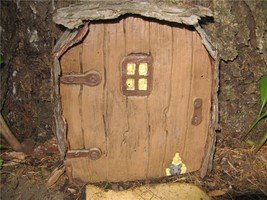
The first item I researched was not the gnome himself, but a door that I could install at the base of a tree to give the appearance that the gnome lived inside. I suspected that I'd find lots more gnomes than I would doors, so I let the door determine the size of my gnome, since I wanted everything to be roughly to scale. The gnome had to be short enough to fit through the door. I also wanted to convey a sense that there were comings and goings into and out of the "home." I decided on a cobblestone path that started at the door and connected to an actual, narrow flagstone path in our gardens. For the "cobblestones" I used flat, smooth pebbles in varying sizes, widely available at craft stores.
Once installed, the door, path, and gnome merged beautifully with the garden setting (photo at right). There was just one challenge left. How would I attract garden visitors' attention to the partially hidden gnome scene? The answer came in the form of a "tree face," those ubiquitous sets of eyes, nose and mouth that, when attached to a tree trunk, give the tree human attributes (see photo below). I positioned the face so that it was approximately eye-level on the tree trunk and christened the tree "Bruce the Spruce." Now, when visitors walk by without noticing the face (or at least not commenting on it), I ask them if they've met Bruce the Spruce and invite them for a closer look. At that point--so far at least--they discover the gnome home at the base of the tree. Their expressions of delight and wonderment make my day! Create Your Own Gnome Home If you'd like to create your own gnome home, here are some sources for materials (click on seller name): Minidoors: Enchanted Gardens (my choice), The Fairy Door and Window Company, Plow and Hearth Gnomes: Local garden centers/craft stores, Gnome Outlet (my choice), Garden Statue Shop, Gnome Town USA, Kimmel Gnomes, Online Discount Mart Pebbles: Local craft stores, Crate and Barrel, Rainbow Turtle No suitable tree? A tree stump will work well, too! What, Exactly, is a Gnome? Compare the size of my gnome in this photo with the Jack-in-the-Pulpit that towers over him. Note also the crossed arms as a sign of his taciturn nature. A group of gnomes is called a donsey. "Gnome hunting" is the illegal practice of stealing garden gnomes. In The Book of Lost Tales by JRR Tolkien, a race of Elves (the Noldoli) are also referred to as Gnomes. The Secret Book of Gnomes was said to have been written by a Gnome called "David." The actual author was a Dutchman named Wil Huygen. Densely planted walkway: The path and gnome home are located in the planting to the left of the arrow and are almost invisible from the walkway. Questions? Comments? Please scroll down to the form below. I enjoy hearing from my readers! You may also be interested in an article by fellow DG writer, Janet Colvin: Garden Art: How Can I Protect and Preserve My Garden Art? © Larry Rettig 2009 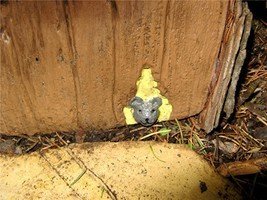
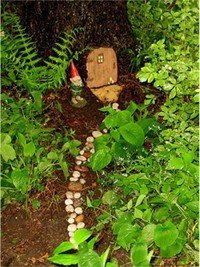
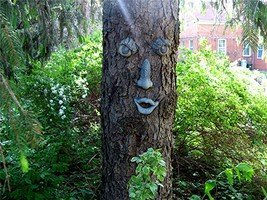
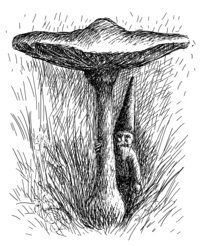 Grouping Fairy
Grouping Fairy
Subgrouping Earth Spirit
Country Europe (initially)
Worldwide
Courtesy of Wikipedia
Known for his small size and somewhat aloof disposition, the gnome is a mythical being that lives in natural areas close to the earth. He is generally bearded and wears a colorful, pointed, conical hat.
The first garden gnomes were made in Gräfenroda, Germany in the mid-1800s by Philip Griebel. His ceramic gnomes were based on local myths, which held that gnomes had an innate willingness to help in the garden at night. The garden gnome is now found across Europe and the U.S. and wherever else gardening is a serious hobby. 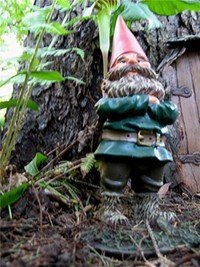
Did You Know?
Gnome names in English Folklore include Sprin, Rumo, Pinny, Fislet and Gulcifer.
Copyright © www.100flowers.win Botanic Garden All Rights Reserved